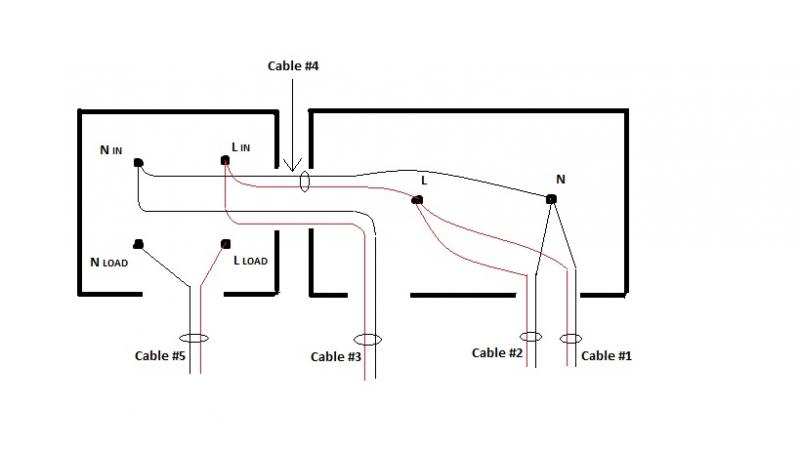Hi
I am redecorating a bedroom and would like to remove two wall lights. This is probably quite a simple one for most of you but I would appreciate it if you could confirm whether my proposal is OK.
The wall in question has a low level double plug socket and a FCU next to it, which isolates the lights. Having undone the face plates, there was one more cable than I was expecting. Here is a sketch:
The nearest wall light has two cables and the next one has one. I have checked that there is continuity between L5 and the L from one of the cables at the first light (although I already knew that the FCU controlled the lights!).
Next I removed the three cables from the L connection behind the socket (L1, L2 & L4). There was continuity between L4 and L1 so I presume that cables 1 & 3 are the cables in and out for the ring (socket isolated by B32 MCB). There is one other double socket in the room which has only one cable behind; there is continuity between the L of this cable and L2. So it looks to be like this is a double socket on a ring with two spurs: one to another double socket (cable #2) and one to the FCU for the lights (cable #4).
Unfortunately removing the cables to the lights doesn't seem to be an option as the cables go through the wall (single skin brick) and the other side is completely tiled (bathroom).
My plan is to:
1. Remove cable 4.
2. Disconnect cable 3 from FCU, cut it back and connect it to double socket.
3. Disconnect cable 5, terminate in a choc block, wrap it in a plastic bag or similar and plaster over where the FCU was.
4. Terminate the cables for the lights in a choc block, wrap in a plastic bag or similar and plaster over.
5. Decorate.
This way, nothing is live, everything is safe and I could always reinstate the lights at a later date if I want. Sound OK?
Thanks in advance.
I am redecorating a bedroom and would like to remove two wall lights. This is probably quite a simple one for most of you but I would appreciate it if you could confirm whether my proposal is OK.
The wall in question has a low level double plug socket and a FCU next to it, which isolates the lights. Having undone the face plates, there was one more cable than I was expecting. Here is a sketch:
The nearest wall light has two cables and the next one has one. I have checked that there is continuity between L5 and the L from one of the cables at the first light (although I already knew that the FCU controlled the lights!).
Next I removed the three cables from the L connection behind the socket (L1, L2 & L4). There was continuity between L4 and L1 so I presume that cables 1 & 3 are the cables in and out for the ring (socket isolated by B32 MCB). There is one other double socket in the room which has only one cable behind; there is continuity between the L of this cable and L2. So it looks to be like this is a double socket on a ring with two spurs: one to another double socket (cable #2) and one to the FCU for the lights (cable #4).
Unfortunately removing the cables to the lights doesn't seem to be an option as the cables go through the wall (single skin brick) and the other side is completely tiled (bathroom).
My plan is to:
1. Remove cable 4.
2. Disconnect cable 3 from FCU, cut it back and connect it to double socket.
3. Disconnect cable 5, terminate in a choc block, wrap it in a plastic bag or similar and plaster over where the FCU was.
4. Terminate the cables for the lights in a choc block, wrap in a plastic bag or similar and plaster over.
5. Decorate.
This way, nothing is live, everything is safe and I could always reinstate the lights at a later date if I want. Sound OK?
Thanks in advance.


